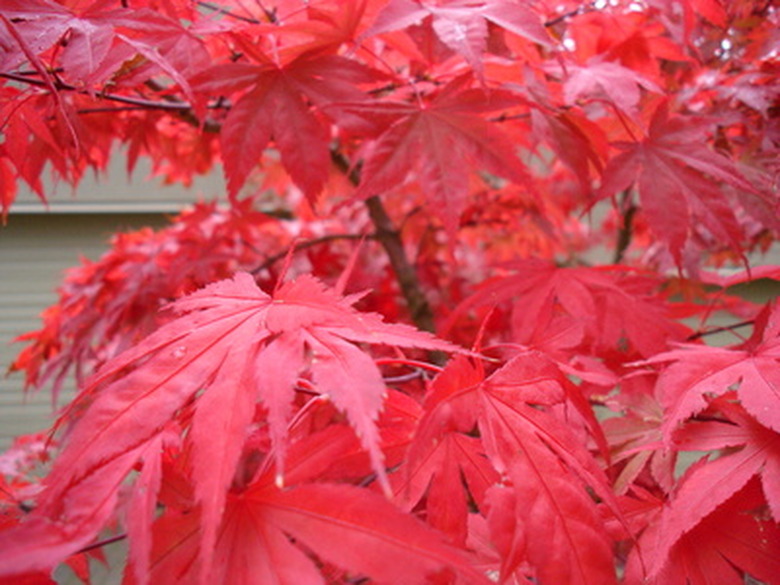The Meaning Of A Japanese Maple Tree
The Iroha-momiji Japanese maple (Acer palmatum) is a deciduous tree, native to the Korean Peninsula and Japan, except Hokkaido, according to Gerard Taaffe, writing in "The Japan Times" of November 28, 2002. Its introduction to Europe took place in 1820, and its popularity soon spread worldwide. The Japanese maple may be a relatively average height at around 25 feet, but it brings new meaning to the power of the "small tree."
Literal Translations
In Japan, the common name of the maple tree is "momiji". There are two possible meanings attached to this term. The first is "baby's hands" and the second is "becomes crimson leaves," according to the Arbor Day website.
By The Book
The meaning of a Japanese maple in the "Random House Unabridged Dictionary, 1997, " is "a small, graceful maple tree, 'Acer palmatum' of Korea and Japan, having small, purple flowers, the foliage turning bright red in autumn. Also called full-moon maple." This definition appears on the Infoplease website, as does an entry from "Thesaurus" that ascribes the botanical name, "Acer japonicum" to the full moon maple.
- The Iroha-momiji Japanese maple (Acer palmatum) is a deciduous tree, native to the Korean Peninsula and Japan, except Hokkaido, according to Gerard Taaffe, writing in "The Japan Times" of November 28, 2002.
- This definition appears on the Infoplease website, as does an entry from "Thesaurus" that ascribes the botanical name, "Acer japonicum" to the full moon maple.
Tourism Benefits
The Japanese maple brings significant meaning to tourism in places like Kyoto. Visitors travel there especially to admire the brilliant autumn leaves of iroha-momiji maples planted in Arashiyama in the Saga area or around Engetsu-kyo. A sub-species, Oo-momiji (Acer palmatum, ssp. Amoenum) grows throughout Japan, frequently in parks and on streets.
Multiple Choices
It is no simple matter to discover what a Japanese maple tree name really means. In the preface to the third edition of "Japanese Maples: momiji and kaede" published by Timber Press in 2001, co-author, Peter Gregory writes: "The index has been expanded to include all the Japanese maple cultivar names published in books, journals, and major catalogs of growers which it has been possible to trace...In the descriptions, the meanings of Japanese names have been added where possible...Numerous Japanese words have several meanings and the Japanese characters for a cultivar name do not necessarily indicate which meaning is intended. Furthermore, even the most comprehensive dictionaries do not cover every meaning."
- The Japanese maple brings significant meaning to tourism in places like Kyoto.
- Visitors travel there especially to admire the brilliant autumn leaves of iroha-momiji maples planted in Arashiyama in the Saga area or around Engetsu-kyo.
The Gardener's Meaning
The Japanese maple means the ideal tree for bonsai practitioners, who cultivate its thread-leaf and lace-leaf varieties. They caution that the correct amount of water and sunlight are crucial to the development of this tree. It is important to ensure that the soil remains moist but never waterlogged, and that the tree gets morning and evening sunlight to reach its full potential. Protect the Japanese maple from hot afternoon sun and harsh winds, which will damage or even burn the beautiful red or green leaves. Humid conditions are the answer to this tree's prayers.
